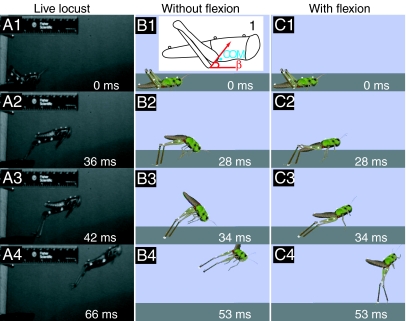Fig. 6.
Comparison of live and simulated jumps with and without dorsiflexion. (A1) Locust 2 just prior to jumping. The initial pitch is small (1.72 deg). (A2) Just before the locust's feet left the ground. The initial pitch remained steady throughout the jump (TOPV=16.4 deg s–1). (A3) 6 ms after it's feet left the ground. A small dorsiflexion of the abdomen is visible. (A4) Final trackable frame of the jump. The locust has pitched up slowly. (B1) Simulated locust prior to jumping with no dorsiflexion. Initial conditions were set to attempt to recreate the jump of the live locust. (1) Inset shows the approximate location of the COM relative to the thrust vector for the simulated jump. (B2) Locust just before the feet left the ground. Unlike the live animal, body pitch of the simulated locust rapidly decreased (TOPV=–2260 deg s–1). (B3) The body somersaulted in a head-downward tumble (clockwise) as the legs swung forward (counter clockwise). (B4) When the limits of the thoracic–coxa joints were reached, the angular opposing momenta of the legs and thorax largely cancelled their rotational movements. (C1) Locust prior to jumping with dorsiflexion. (C2) Initial pitch was very similar to the live locust and remained nearly constant throughout the jump impulse (TOPV=–2.59 deg s–1). (C3) A dorsiflexion began immediately after the thrust was finished. (C4) The locust activated the dorsal longitudinal muscle and not the ventral longitudinal muscle, and so dorsiflexion reached a maximum and was maintained throughout the jump. The tumbling rate was positive (TUPV=365 deg s–1).

